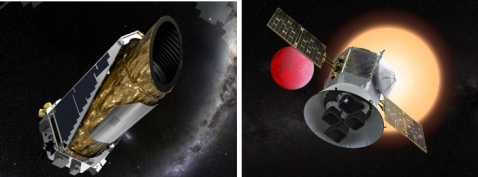Kepler vs. TESS
Kepler and TESS are both amazing space telescopes that have and will revolutionise our understanding of exoplanets. But let’s have a look at how these two telescopes differ?

Artist impression of NASA’s planet-hunting Kepler spacecraft (left) and TESS satellite (right). Image credit: NASA Ames/JPL-Caltech/T Pyle
Kepler was launched in March 2009 and used a 1.4-m primary mirror that observed a 12×12 degree patch of sky (for reference the Moon covers half a degree on the sky). The sensitivity of Kepler was significantly better than that of any other instruments at the time, thus enabling Kepler to find exoplanets as small as half the size of the Earth.
Conversely, TESS will survey the entire sky, looking at 400 times more stars than Kepler did throughout its lifetime. TESS will do this with four identical telescopes, which, combined, observe a 24-degree patch of sky at any one point. Each 27 days, TESS changes direction and looks for planets around a different set of stars in a new ‘sector’. The entire sky has been split into 26 overlapping sectors, and TESS will visit each one over the course of the next 2 years.

The combined field of view of the four TESS cameras (left) and the sub-division of the celestial sphere into 26 observation sectors (right). Image credit: NASA
The two satellites also differ in their observing strategy and the types of stars that they focus on. Whilst Kepler observed one patch of sky for a long period of time, TESS will only spend a month looking at each sector. The long exposure times of Kepler allowed it to find the dimmer and more distant stars, whereas TESS will monitor the nearby, and brightest targets. In fact, the stars observed by TESS are 10 times closer and 100 times brighter than the Kepler target stars! Observing brighter and closer stars has the advantage that any planet candidates that we find will be easier to observe using ground based telescopes.

Artist impression of a burning exoplanet. Image credit: NASA
The main Kepler mission ended in 2013, when the telescope lost its ability to change orientation without the use of fuel. Luckily, engineers and astronomers quickly realised that the pressure from the Sun could be used to steer the telescope in order to keep it pointing at one patch of the sky. This new era of observations became known as the K2 mission.
K2 ran out of fuel in mid 2018, bringing the mission to a close. Luckily, by this point NASA’s new satellite TESS had already been launched. We now have brightness measurements of around 45,000 stars from the first three sectors, and we are already finding some promising planet candidates within the TESS data!
Will you help us find the planets hidden within the TESS data? Click here to give it a go!
